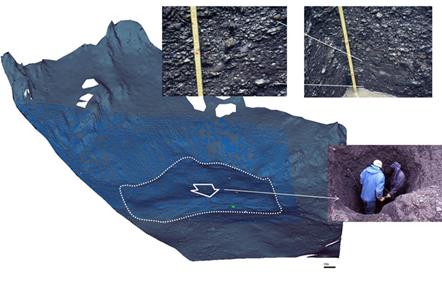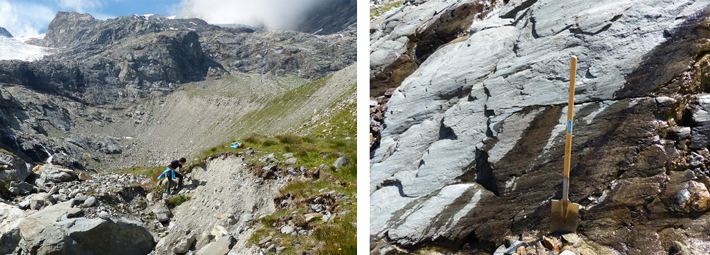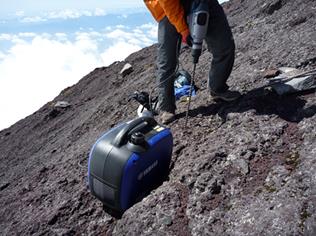TSUKUBA FUTURE
#071 Investigating Mountains by Digging Frozen Ground
Associate Professor IKEDA Atsushi, Faculty of Life and Environmental Sciences

More people these days are taking up hiking in the mountains. The exhilaration of reaching the top of a mountain and the joy of discovering alpine plants and unusual landforms are great attractions for hikers. Knowing how such terrain was formed may also add to the wonder and pleasure of being in the mountains. However, few people clearly recall having ever studied mountain topography or terrain. Was it in earth science or geography? Professor Ikeda's activities range from the study of geomorphology to the teaching of geography.
Mountains such as the Japanese Alps, Swiss Alps, and the Himalayas were formed by dynamic movements of the earth's crust, as tectonic plates collided in these regions. In addition to uplift due to tectonic deformation, mountain topography is affected by various other physical phenomena both underground and at the ground surface. Prof. Ikeda has always loved climbing mountains and was soon fascinated by stories that the distinctive topography above the tree line in Japanese mountains was formed during glacial periods. To find out about actual conditions of the glacial period that lasted until 10,000 years ago in Japan, he first studied the present alpine conditions in the Swiss Alps. On the advice of his academic supervisor in the graduate school, Prof. Ikeda chose to study rock glaciers. These are tongue-shaped landforms covered with rocky debris that develop on steep slopes in a cold climate. They can extend downward from several tens of meters to several kilometers. They move slowly, like glaciers, at a rate of several centimeters or more per year.
Focused on one small rock glacier, he drilled a hole and started to monitor subsurface temperature and deformation. In general, a rock glacier is frozen inside, and moves very slowly because the ice is a slimy material. Yet, it was found that the surveyed rock glacier moved faster than conventional slow deformation theories could explain. What had happened was that the ice had not only deformed but water had gotten into the cracks in the deformed ice and further facilitated the movement due to global warming forming the ice immediately prior to melting.
There is a controversy about the origin of ice in rock glaciers. One theory is that they originally develop as ice glaciers and are covered with debris afterward. Another is that the ice fills the voids after accumulation of debris, forming permafrost. In the observations Prof. Ikeda has made, most rock glaciers fall into the latter category. Although in the traditional permafrost theory the dominant process of the ice formation is assumed to be frost heave originating from ground water, Prof. Ikeda asserts that from indirect evidence late-lying snow is occasionally buried with debris from slope failure. Consequently, snow that would have melted without the sediment does not melt and contributes to the enlargement of the rock glacier.

The studied rock glacier in the Swiss Alps. The area within the dotted line has permafrost approximately 10 meters thick, moving at the rate of about one meter per year in the direction of the arrow. Such movement indicates that the frozen ground is very soft. Digging down 2.2-2.7 meters, gravel in ice was found (photo above). The scale below (black line) shows a length of 10 meters.
Geological phenomena accounting for landforms take place over long periods of time, thus the processes behind them are often difficult prove using current observations alone. However, immediately after Prof. Ikeda published his hypothesis on ice formation, it was corroborated by another researcher. In a mining town in the Arctic, it was observed that snow accumulated on a large plastic sheet covering part of a rock glacier survived the following warm season only if the snow was covered by sediment. Moreover, using mine shafts for observation, it was confirmed that the internal structure of the rock glacier closely matched experimental results.

Digging in the Swiss Alps
Still, Switzerland and the Arctic Circle are far from home for Prof. Ikeda, so he has sought to pursue his fieldwork in Japan. His attention turned to Mt. Fuji. At that time, the media was spreading an idea that the permafrost on Mt. Fuji had rapidly melted due to atmospheric warming. Yet up to that point nobody had actually drilled into the permafrost for evidence. Prof. Ikeda teamed up with a researcher from Hokkaido University to find a location atop Mt. Fuji that would be likely to have permafrost to drill (of course with permission). They drilled two deep holes but found nothing. In their third hole, they finally found permafrost. Why was it so difficult to find permafrost on Mt. Fuji? Rainwater from typhoons is easily absorbed into the volcanic ground and in most spots atop Mt. Fuji there is no permafrost. Permafrost only exists in places where rainwater does not easily seep into the ground. Under the atmospheric warming of recent years, seasonal frozen soil has tended to melt earlier, and the idea of rapid permafrost melting was from misinterpretation of this early melt of seasonal frost. Several more decades will still be necessary to know the effects of global warming on permafrost on Mt. Fuji.

Drilling on Mt. Fuji
For the last three years Prof. Ikeda has conducted fixed point observation at Mt. Fuji and other locations, while also working on revisions to a high school geography textbook. While going over existing entries in the natural science section of the textbook, he was surprised to find theories that had become outdated over the last half-century. He also found that high school teachers of social studies who taught geography needed support. The academic discipline of geography, which originally arrived in Japan from Europe, should not be a specialized area of social studies, he feels, but a comprehensive field that combines human geography and natural science, derived from the study of natural history. In the College of Geoscience at the University of Tsukuba there are faculty who teach geoscience in both areas--humanities and natural science. From geomorphology research to geography education, Prof. Ikeda views his pursuits as the personal mission that he has been given.
Article by Science Communicator at the Office of Public Relations


